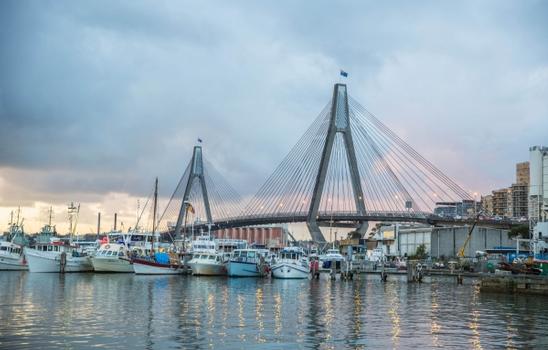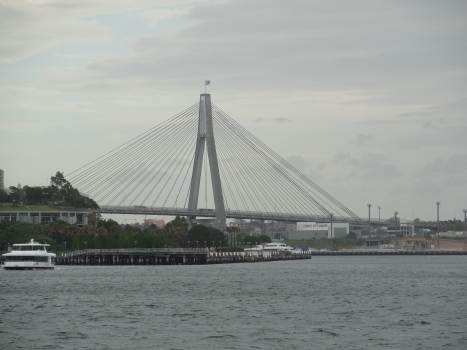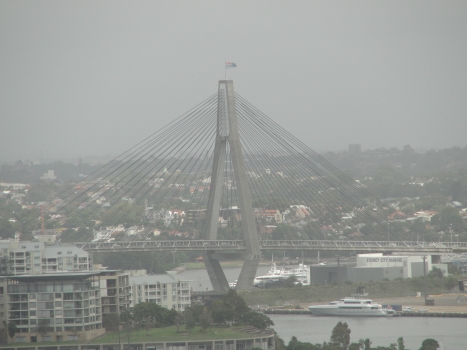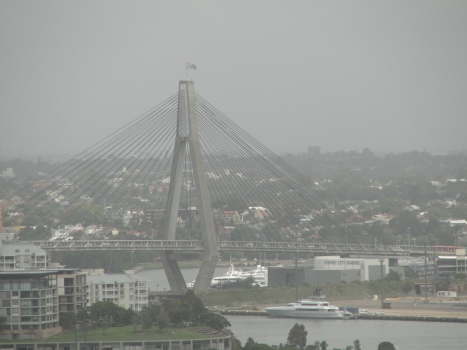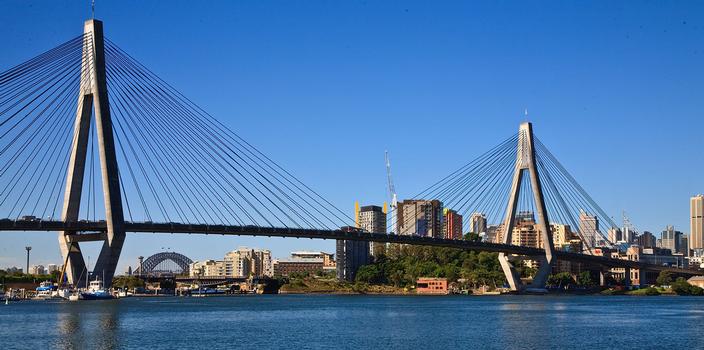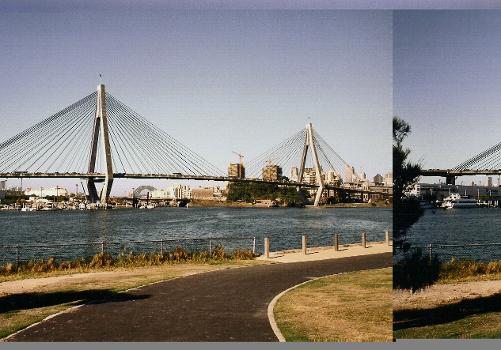General Information
| Other name(s): | Glebe Island Bridge |
|---|---|
| Beginning of works: | 1992 |
| Completion: | 3 December 1995 |
| Status: | in use |
Project Type
| Structure: |
Cable-stayed bridge with semi-fan system |
|---|---|
| Function / usage: |
Motorway bridge / freeway bridge |
| Material: |
Prestressed concrete bridge |
| Support conditions: |
for registered users |
| Plan view: |
Structurae Plus/Pro - Subscribe Now! |
| Structure: |
Three-span cable-stayed bridge |
| Material: |
Structurae Plus/Pro - Subscribe Now! |
| Secondary structure(s): |
Structurae Plus/Pro - Subscribe Now! |
| Material: |
Structurae Plus/Pro - Subscribe Now! |
| Secondary structure(s): |
Structurae Plus/Pro - Subscribe Now! |
Location
| Location: |
Pyrmont, City of Sydney, Sydney, New South Wales, Australia Rozelle, Municipality of Leichhardt, Sydney, New South Wales, Australia |
|---|---|
| Crosses: |
|
| Coordinates: | 33° 52' 9" S 151° 11' 9" E |
Technical Information
Dimensions
| total length | 805 m | |
| number of lanes | 8 | |
| deck | deck width | 32.2 m |
| main bridge | ||
|---|---|---|
| main span | 345 m | |
| span lengths | 140 m - 345 m - 140 m | |
| number of spans | 3 | |
| pylons | height | 69 m |
Cost
| cost of construction | Australian dollar 80 000 000 |
Materials
| deck |
prestressed concrete
|
|---|---|
| piers |
reinforced concrete
|
| pylons |
reinforced concrete
|
| abutments |
reinforced concrete
|
| pylon heads |
composite steel-reinforced concrete
|
Notes
ANZAC = Australia & New Zealand Army Corps
Excerpt from Wikipedia
The Anzac Bridge is an eight-lane cable-stayed bridge that carries the Western Distributor (A4) across Johnstons Bay between Pyrmont and Glebe Island (part of the suburb of Rozelle), on the western fringe of the central business district of Sydney, New South Wales, Australia. The bridge forms part of the road network leading from the central business district, the Sydney Harbour Bridge, and Cross City Tunnel to the Inner West and Northern Suburbs.
History
Glebe Island Bridges
There were two bridges over Johnstons Bay before the construction of the Anzac Bridge.
The first bridge was constructed as part of a project to move the abattoirs out of central Sydney, and to construct public abattoirs at Glebe Island. The first pile of the original bridge was driven in October 1860. The bridge was opened in 1862 and was a timber beam bridge 318.6 metres (1,045 feet 5 inches) long and 8.5 m (28 ft) wide with a 12 m (40 ft) swing section on the eastern side. It replaced a double steam punt crossing.
The second Glebe Island Bridge was an electrically operated swing bridge opened in 1903, the year after the opening of the new Pyrmont Bridge over Sydney's Darling Harbour, which has a similar design. The bridge was designed by Percy Allan of the New South Wales Public Works Department who also designed the Pyrmont Bridge. Delays due to increasing traffic, which were exacerbated by having to close a major arterial road to allow the movement of shipping into Blackwattle Bay, led to the construction of the present-day Anzac Bridge. The 1903 bridge is still standing, but there is no access to pedestrians or vehicular traffic.
Anzac Bridge
The stay cable design concept development and final design for the new bridge were carried out by a team from the NSW Roads & Traffic Authority, led by their Chief Bridge Engineer Ray Wedgwood and the construction by Baulderstone. The bridge was opened to traffic on 3 December 1995 as the Glebe Island Bridge.
The bridge was given its current name on Remembrance Day in 1998 to honour the memory of the soldiers of the Australian and New Zealand Army Corps (known as Anzacs) who served in World War I. An Australian Flag flies atop the eastern pylon and a New Zealand Flag flies atop the western pylon. A bronze memorial statue of an Australian Anzac soldier ("digger") holding a Lee–Enfield rifle in the "rest on arms reverse" drill position was placed on the western end of the bridge on Anzac Day in 2000. A statue of a New Zealand soldier was added to a plinth across the road from the Australian Digger, facing towards the east, and was unveiled by Prime Minister of New Zealand Helen Clark in the presence of Premier of New South Wales Morris Iemma on Sunday 27 April 2008.
Description
The bridge is 32.2 m (105 ft 8 in) wide and the main span is 345 m (1,132 ft) long. The reinforced concrete pylons are 69 m (226 ft) high and support the deck by two planes of stay cables. Initially the stay cables were plagued by vibrations which have since been resolved by the addition of thin stabilising cables between the stay cables.
There is a grade-separated shared pedestrian footpath and cycleway located on the northern side of the bridge, making possible a walk from Glebe Point Road, down Bridge Road, over the bridge and round Blackwattle Bay back to Glebe Point Road.
The bridge can carry a maximum of 180,000 cars per day. It reached its maximum capacity in 2002, only seven years after it was finished.
The bridge is regularly patrolled by security guards as a counter-terrorism measure. Security cameras also monitor the walkway.
The bridge has a speed limit of 60 kilometres per hour (37 miles per hour): it was reduced from 70 km/h (43 mph) in January 2005. Also prior to that date, the bridge had seven traffic lanes (4 eastbound, 3 westbound).
Originally, there were bus stops at the western end of the bridge, but they were removed because buses pulling out from the stops created a hazard as they merged with other traffic moving at (or close to) the speed limit. The Australian Anzac statue on the northern side of the bridge is adjacent to the former city-bound bus stop; the New Zealand Anzac statue was installed within the ramp area of the former stop on the southern side.
Text imported from Wikipedia article "Anzac Bridge" and modified on February 21, 2022 according to the CC-BY-SA 4.0 International license.
Participants
Relevant Web Sites
Relevant Publications
- (2012): ANZAC Bridge Maintenance Project. Presented at: 18th IABSE Congress: Innovative Infrastructures – Towards Human Urbanism, Seoul, Korea, 19-21 September 2012, pp. 1468-1475.
- (2013): ANZAC Bridge Stay Cable Upgrade. Presented at: IABSE Conference: Assessment, Upgrading and Refurbishment of Infrastructures, Rotterdam, The Netherlands, 6-8 May 2013, pp. 640-641.
- (1998): Balancing Act. In: Civil Engineering Magazine, v. 68, n. 2 (February 1998), pp. 42-45.
- (1994): Glebe Island bridge - Australia's new cable-stayed bridge (Australia). Presented at: International Conference IABSE-FIP: Ponts suspendus et à haubans = Cable-stayed and suspension bridges, Deauville, France, 12-15 October 1994, pp. 307.
- (1995): Die Glebe-Island-Schrägkabelbrücke in Sydney. In: Beton- und Stahlbetonbau, v. 90, n. 12 (December 1995), pp. 304-310.
- About this
data sheet - Structure-ID
20001191 - Published on:
17/01/2001 - Last updated on:
09/02/2021

